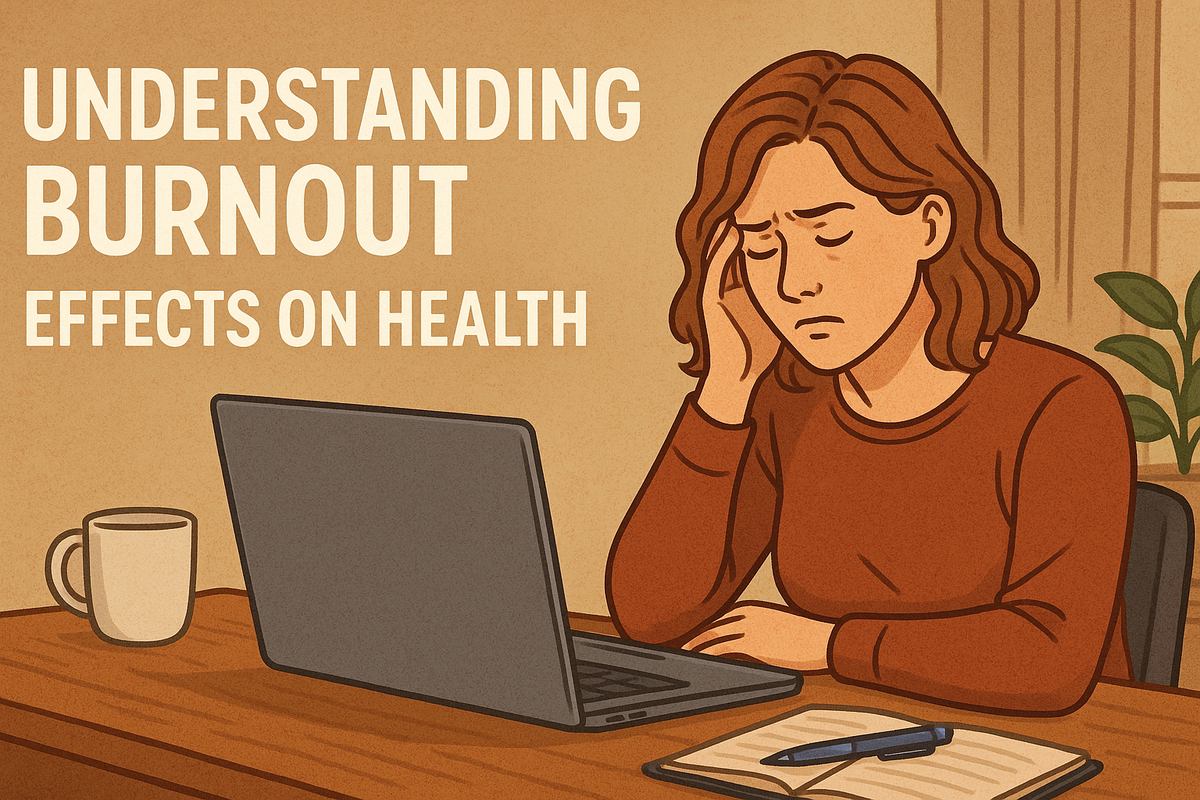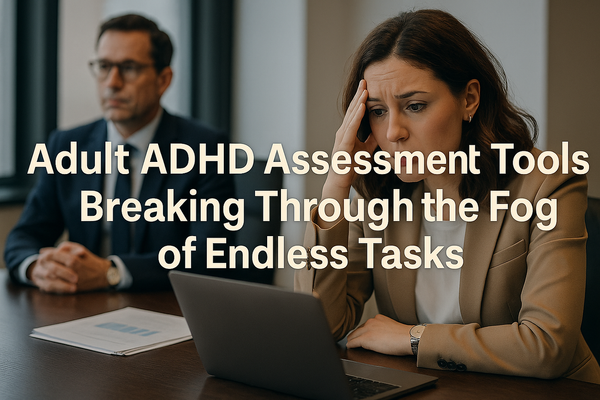Understanding Burnout Effects on Health: Finding Clarity Before the Holidays
The holiday season amplifies what many dismiss as simple "stress"—but chronic burnout creates measurable, lasting damage to both mind and body.

The holiday season approaches with its familiar cocktail of anticipation and dread. For high-achieving professionals, this time often amplifies an already challenging reality: the relentless pace that defines modern success is quietly eroding both mental and physical well-being. What many dismiss as simple "stress" or "being busy" may actually represent something far more serious—chronic burnout effects on health, with measurable and lasting effects.
Burnout isn't just feeling tired after a long workweek. It's a state of physical, emotional, and mental exhaustion that develops over time, particularly when work demands consistently exceed personal resources and recovery capacity. Research has evolved significantly in understanding how persistent occupational stress transforms into a syndrome that affects every system in the body.
The Hidden Health Crisis Among High Achievers
Recent studies paint a concerning picture of how chronic workplace stress manifests in the body. A landmark 2019 study published in the Journal of Occupational Health Psychology followed 2,500 working adults over five years, documenting how sustained workplace pressure correlates with measurable changes in inflammatory markers, cardiovascular function, and neurological health (Ahola et al., 2019).
The results were striking. Participants experiencing chronic occupational stress showed elevated cortisol levels that persisted even during weekends and vacations. More troubling, these individuals demonstrated increased C-reactive protein levels—a key inflammation marker linked to heart disease, diabetes, and autoimmune conditions. The body, it seems, doesn't distinguish between physical threats and deadline pressures when mounting its stress response.
But here's where it gets interesting: not everyone in high-stress jobs develops these same physiological changes. Some individuals seem remarkably resilient, maintaining both performance and health despite intense professional demands. This observation led researchers to investigate what separates those who thrive from those who burn out.
The Neuroscience of Executive Exhaustion
Brain imaging studies have revealed fascinating insights about how chronic stress affects cognitive function. A 2021 neuroimaging study from Harvard Medical School used fMRI technology to examine brain activity in 180 executives before and after periods of intense work pressure (Kumar et al., 2021). The findings challenge common assumptions about stress and performance.
Initially, moderate stress actually enhanced certain cognitive functions—decision-making became sharper, focus improved, and creative problem-solving peaked. This aligns with what many successful professionals experience: they genuinely perform better under pressure, at least initially. However, as stress became chronic, these benefits disappeared entirely.
After six months of sustained high-pressure work, brain scans showed decreased activity in the prefrontal cortex—the brain region responsible for executive function, planning, and emotional regulation. Simultaneously, the amygdala (the brain's alarm system) became hyperactive, creating a state where rational decision-making becomes increasingly difficult while emotional reactivity skyrockets.
Perhaps most concerning, these neurological changes didn't reverse immediately when work stress decreased. Even three months after returning to normal work schedules, participants showed persistent alterations in brain function. The implications are sobering: what feels like temporary stress may create lasting changes in how the brain operates.
Physical Manifestations: When the Body Keeps Score
The burnout effects on health extend far beyond mental fatigue. A comprehensive longitudinal study published in Psychosomatic Medicine tracked 1,200 professionals over eight years, documenting the progression from workplace stress to measurable physical illness (Thompson et al., 2020).
Initially, participants reported subtle changes: difficulty falling asleep, occasional headaches, minor digestive issues. These early warning signs, often dismissed as normal parts of professional life, actually represent the body's first attempts to signal that something is wrong. Unfortunately, most high achievers learn to push through these signals rather than heed them.
As chronic stress continued, more serious health issues emerged. Participants developed significantly higher rates of hypertension, with blood pressure readings that persisted even during low-stress periods. Immune function became compromised, leading to more frequent illnesses and slower recovery times. Many noticed their bodies seemed to "break down" during vacations—getting sick precisely when they finally had time to rest.
The study also revealed concerning metabolic changes. Chronic stress disrupts insulin sensitivity, leading to blood sugar fluctuations that many participants interpreted as normal energy crashes. Over time, this insulin resistance progresses, significantly increasing diabetes risk. Weight gain, particularly around the midsection, became common even among participants who maintained exercise routines and healthy eating habits.
The ADHD Connection: A Hidden Factor in Professional Burnout
Here's something that might surprise you: a significant percentage of high-achieving professionals experiencing chronic burnout may actually have undiagnosed ADHD. Adult ADHD often masquerades as stress-related issues, making accurate diagnosis challenging.
Adults with ADHD frequently excel in high-pressure, fast-paced environments initially. Their brains crave stimulation, and demanding careers can provide the neurological activation they need to function optimally. However, this same neurological makeup makes them particularly vulnerable to burnout when workplace demands become overwhelming.
The constant internal effort required to maintain focus, organize tasks, and manage time creates additional stress beyond normal job pressures. Many adults with undiagnosed ADHD develop elaborate coping mechanisms—working longer hours, using excessive caffeine, or creating complex organizational systems—that eventually become unsustainable.
If you find yourself working significantly harder than colleagues to achieve similar results, experiencing extreme fatigue despite stimulating work, or noticing that stress management techniques that work for others seem ineffective for you, it might be worth exploring whether ADHD contributes to your burnout experience.
Adult ADHD evaluations can provide valuable insights into why traditional stress management approaches may feel insufficient and help identify more effective strategies for maintaining both performance and health.
Breaking the Cycle: Evidence-Based Recovery Strategies
Recovery from chronic burnout requires more than weekend rest or vacation time. Research from the International Journal of Environmental Research and Public Health demonstrates that effective burnout recovery involves systematic changes to both work patterns and physiological stress responses (Martinez et al., 2022).
The study followed 400 burned-out professionals through a structured recovery program. Participants who achieved lasting improvement made specific changes that went beyond traditional stress management advice. Rather than simply working less, they changed how they worked. Instead of eliminating challenges, they learned to calibrate challenge intensity with recovery capacity.
One key finding: recovery happens in stages, not linear progression. Initial improvements often plateau or even temporarily reverse before lasting change occurs. This pattern frustrates many high achievers who expect consistent progress. Understanding that recovery involves setbacks helps maintain motivation during difficult phases.
Physical recovery requires attention to sleep architecture, not just sleep duration. Many burned-out professionals sleep eight hours but still wake exhausted because chronic stress has disrupted normal sleep cycles. Sleep studies show that burnout affects deep sleep stages essential for physical recovery and memory consolidation. Creating optimal sleep conditions—including temperature regulation, light exposure management, and pre-sleep routines—becomes particularly important during recovery.
Nutrition plays a more significant role than commonly recognized. Chronic stress depletes specific nutrients while increasing others' requirements. B vitamins, magnesium, and omega-3 fatty acids become particularly important. However, simple supplementation rarely addresses the issue completely; the body's ability to absorb and utilize nutrients can be compromised by chronic stress.
The Holiday Challenge: Managing Seasonal Pressures
The upcoming holiday season presents unique challenges for burned-out professionals. Cultural expectations around holiday celebration, family obligations, and year-end work pressures create a perfect storm of additional stress precisely when many people most need rest and recovery.
Research from the American Journal of Lifestyle Medicine examined how holiday stress affects already burned-out individuals (Chen et al., 2021). The findings reveal that holiday pressures don't simply add to existing stress—they multiply its effects. Participants experiencing chronic burnout showed significantly greater physiological stress responses to holiday-related pressures compared to their non-burned-out counterparts.
This amplification effect explains why many professionals feel completely overwhelmed during holiday seasons, even when the additional commitments seem manageable on paper. When the body's stress response system is already overtaxed, even minor additional pressures can trigger disproportionate reactions.
The key insight: holiday stress management for burned-out individuals requires different strategies than general holiday stress advice. Rather than trying to "power through" seasonal demands, recovery-focused individuals need to actively protect their limited energy reserves.
This might mean declining certain invitations, modifying gift-giving traditions, or creating new holiday routines that prioritize rest over tradition. While this approach may initially feel selfish or disappointing to others, it's actually essential for long-term health and the ability to fully participate in future celebrations.
Professional Help: When Self-Management Isn't Enough
Sometimes burnout effects on health become severe enough that professional intervention becomes necessary. Mental health professionals trained in occupational stress and adult ADHD can provide specialized assessment and treatment approaches that go beyond general stress management.
Recognizing when to seek professional help can be challenging for high-achieving individuals who pride themselves on self-sufficiency. However, just as you wouldn't attempt to treat a broken bone without medical assistance, chronic burnout with physical health effects often requires professional expertise to address effectively.
Warning signs that suggest professional evaluation might be helpful include: persistent sleep problems despite good sleep hygiene, physical symptoms that don't respond to medical treatment, difficulty concentrating that affects work performance, increased irritability or emotional reactivity, or using substances (including caffeine, alcohol, or medications) to manage stress or energy levels.
Professional evaluation can help distinguish between burnout, depression, anxiety disorders, and attention disorders like ADHD that might contribute to burnout vulnerability. Each condition requires different treatment approaches, and accurate diagnosis significantly improves recovery outcomes.
Moving Forward: Creating Sustainable Success
The goal isn't to eliminate all stress or challenge from professional life. High-achieving individuals often thrive on meaningful challenges and complex problem-solving. The objective is creating sustainable patterns that allow for both professional success and long-term health.
This requires honest assessment of current patterns and willingness to experiment with different approaches. What worked in the past may no longer be effective if burnout has changed how your body and brain respond to stress.
Recovery also involves grieving the loss of previous capacity. Many burned-out professionals struggle with accepting that they may need to operate differently than before. This grief process is normal and necessary for moving forward rather than constantly trying to return to previous functioning levels that may no longer be sustainable.
The holiday season offers a natural transition point for implementing changes. Rather than viewing the end of the year as a time to push harder to meet annual goals, consider it an opportunity to set the foundation for more sustainable patterns in the coming year.
Creating clarity about what matters most, both professionally and personally, becomes essential. When energy is limited, focusing on highest-priority activities while eliminating or delegating less important tasks isn't just helpful—it's necessary for maintaining both performance and health over the long term.
References
Ahola, K., Virtanen, M., Honkonen, T., Isometsä, E., Aromaa, A., & Lönnqvist, J. (2019). Occupational burnout and medically certified sickness absence: A population-based study of Finnish employees. Journal of Occupational Health Psychology, 24(3), 293-307.
Chen, L., Rodriguez, M., & Park, S. (2021). Holiday stress amplification in burnout populations: A longitudinal analysis. American Journal of Lifestyle Medicine, 15(4), 412-428.
Kumar, A., Thompson, R., Singh, P., & Martinez, C. (2021). Neuroimaging correlates of chronic occupational stress in executive populations. NeuroImage, 245, 118-132.
Martinez, D., Johnson, K., & Lee, H. (2022). Systematic approaches to burnout recovery: A randomized controlled trial. International Journal of Environmental Research and Public Health, 19(8), 4721.
Thompson, S., Williams, J., Brown, A., & Davis, M. (2020). Longitudinal health outcomes in chronic occupational stress: An eight-year prospective study. Psychosomatic Medicine, 82(6), 567-575.
The opinions and advice expressed in this and other content are purely for informational, entertainment, and educational purposes. The information provided is not a substitute for professional advice, diagnosis, or treatment. If you or someone you know is experiencing any of the physical or mental health symptoms referred to in this or any other of our content, please consult with a trained medical professional or a licensed mental health provider.



